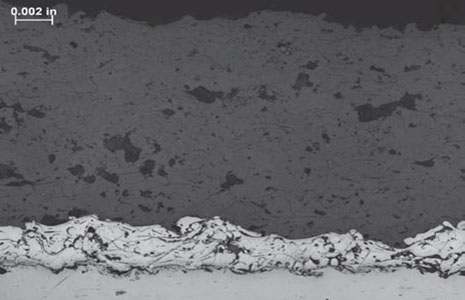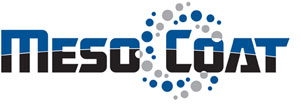Holdings
PComP™ - Corrosion and Wear Coating Materials
Imagine advanced coating materials that are put through the toughest abuse and still come out shining. Coatings that last longer than us. Coatings that are not just good for one application but can withstand severe wear, corrosion and thermal conditions in a variety of applications. PComP™ coatings increase the life of components by 3-20x and yet are cheaper, lighter, and save us from using toxic materials.
Abakan's portfolio company, MesoCoat, is recognized as among the world’s leaders in producing and assembling nanoengineered composite materials. PComP’s are cermets fabricated into a hierarchical structure, developed with microstructures engineered at the nano-, micro- and meso- scale to offer revolutionary performance and cost breakthroughs. These materials are formed with a nanocomposite core and binder coating, which are made using combination of low friction, high wear resistance and excellent corrosion resistant materials. The nanocomposite core provides high wear resistance, low friction and light weight; and the binders provide corrosion resistance, toughness, ductility, resiliency, and improved deposition efficiency. This combination results in a high-toughness, ductile-phased toughened structure of high hardness tiles separated by ductile binder laminates. PComP™ cermet coatings replace electrolytic hard chrome, electroplating, spray and fuse, and thermal spray carbides; to impart wear and corrosion resistance, and reduce friction in sliding wear applications. Cermet coatings are easy and fast to apply, and machine to tight tolerances for dimensional restoration of OEM or worn E&P; components. The PComP™ family of coating materials has been designed to act as drop-in replacements for thermal spray powders and will work with today’s existing application systems.
PComP™ - Value Proposition
- Lowest life cycle cost for steel components in severe environments
• 2X chrome, 0.5X WC, 10-50X life - Drop-In replacement for Tungsten carbide
- Ideal Chrome replacement
- Higher Spray cell and grinding productivity
- Reduces risk of failures (low spallation)
- Eliminates burning of high strength steels
- 4-10X toughness/ductility of standard carbide coatings
- Up to 100X lower system wear
- Environmentally friendly, no hexavalent chrome, nickel, cobalt waste
PComP™ Product Line
PComP™ T45
High Toughness, Corrosion resistant Nanostructured Titanium cermet
Higher toughness, corrosion resistant nanostructured titanium cermet materials are highly resilient, machine quickly, have very low friction, and replaces chrome plating and carbides coatings in shaft, seal, plunger, and valve applications. PComP™ T-HT can be machined with standard grinding process eliminating the need for the expensive diamond grinding process, and has build-up rates 3-5 times to that of carbides (reducing spray time up to 80%); and the high build rate and low stress attributes allow refurbishment of worn components up to 0.025 inches.
PComP™ T48
Higher Hardness, Wear resistant nanocomposite cermet with cobalt-based matrix
Higher hardness wear resistant nanocomposite cermet with cobalt-based matrix provides higher wear resistance than PComP™ T-HT when in contact with drilling mud, coupled with a good corrosion resistance. These materials are primarily used in sliding wear applications, especially in environments that contain suspended solids.
PComP™ S65
Lower Density, Low Spallation corrosion resistant silicon nitride based cermet
Lower density, spallation-resistant nanostructure silicon-titanium cermet material for wear and corrosion protection is an ideal replacement for the toxic chrome plating in aerospace and other weight critical applications. These materials have half the density of hard chrome, are similar in hardness, and offer better wear and corrosion protection. Lower density of these materials lead to substantial weight reductions in aircraft parts and other weight critical applications; leading to massive fuel savings. PComP™ ST materials can be applied 3-5 times thicker than alternative coating materials; and hence allows refurbishment and reuse of a large percentage of worn components, which would otherwise be scrapped and thereby opening up a huge market opportunity.
PComP™ W611
Premium High toughness nanoengineered WC-Co cermet
Premium high toughness nanoengineered tungsten-carbide-cobalt (WC-Co) materials; having high deposition efficiency, and 5-7 times ductility and toughness of conventional carbide. These materials are ideal for use in valve trim and seats on gate valves, sand erosion, and three body wear environments. PComP™ W test results have shown 3-7 times life in downhole applications over conventional materials; leading to lowest coating life cycle cost in this segment.
PComP™ W333
Premium High toughness nanoengineered WC-NiCr cermet
Premium High toughness nanoengineered WC-NiCr system. High deposition efficiency, and 4-7X the toughness of conventional carbide at 1200-1600VHN. It is ideal for use in valve trim and seats on gate valves, and in sand erosion and three body wear environments. Shows 3-7X life in downhole applications.
PComP™ M
High toughness, corrosion and wear resistant nanoengineered nitride- and boride-based cermets (Currently under development)
High toughness, corrosion and wear resistant nanoengineered nitride- and boride-based cermets that also incorporate solid lubricants that provide ultimate wear and corrosion resistance in liquid metal corrosion and solid lubrication conditions for both new coatings and repair in applications like zinc pot rolls, metal processing, metal forming, wind energy, die casting, stamping, forging, etc.
Product |
Replacing |
Why? |
PComP™ S |
Replacing hard chrome platings in aerospace applications. | The application of hard chrome plating creates a form of chrome called hexavalent chrome that is toxic and a known carcinogen. Hence, many countries in EU are in the process of banning its use. Recent changes in U.S. federal acquisition regulations have banned the purchase of systems and components which have been treated using hexavalent chrome plating techniques, creating a burgeoning demand for cost-effective, rapidly deployable alternatives such as PComP™ S, which has low coefficient of friction, is easily machinable and has low weight and high toughness. |
PComP™ T |
Replacing hard chrome plating in applications other than aerospace – Hydraulic cylinders, Boilers, Chemical, and Petrochemical application. | PComP™ T family of coatings offer a low coefficient of friction and superior corrosion resistance when compared to the currently used hard chrome platings and carbide coatings. It is robust, has build-up rates of 2-3X to that of carbides and is easily machinable. It is a perfect replacement of the toxic and carcinogenic chrome in applications other than aerospace. |
PComP™ W |
Replacing conventional tungsten carbide coatings applications in all indutries. | Tungsten carbide coatings are widely used in many different industies for wear and corrosion resistance. PComP™ W family of coatings provide 3-5X the toughness of standard tungsten carbide coatings, with 2X the abrasive and sliding wear resistance. |
ZComP™ - Thermal Barrier Coating Materials
ZComP™ family of thermal barrier coating materials are low radioactivity, multi-oxide component, sintering resistant, partially stabilized zirconia, thermal barrier coating (TBC) material. ZComP™ multi-oxide formulation results in a 50% lower thermal conductivity than single-oxide zirconia’s. By eliminating impurities, such as silica from the material, ZComP’s have shown excellent thermal fatigue properties.
 The ZComP 844 nanocomposite thermal barrier coating (TBC) has about half of the thermal conductivity of standard thermal barriers. Applying the TBC to engine components can result in a 50-percent increase in component life as a result of reduced thermal stress.
The ZComP 844 nanocomposite thermal barrier coating (TBC) has about half of the thermal conductivity of standard thermal barriers. Applying the TBC to engine components can result in a 50-percent increase in component life as a result of reduced thermal stress.
Typical Material Properties
Attribute |
Value |
| Density (g/cc) | 4.5 – 6.5 |
| Thermal Conductivity (W/m-K) | < 1 |
| Melting Point (ºC) | ~ 2700 |
| Radioactivity (Bq/kg) | < 100 |
Value Proposition
Every time a jet engine is started, it goes through a thermal cycle of extreme temperatures, reaching as high as 2,700 °F within the engine’s combustor. Over time, the expansion and contraction of engine parts caused by this cycle lead to cracking and degradation that shortens an engine’s lifespan and eventually necessitates costly replacement. Thermal Barrier Coating are essential for providing an unrivaled means of protecting these engines from the degrading effects of thermal stresses, prolonging their lifespans, and enhancing their reliability and fuel efficiency.
TBCs are ceramic coatings with low thermal conductivity, insulating the metal parts they are applied to and reducing thermal fatigue. The ceramic component is typically composed of zirconium oxide (zirconia) stabilized in a particular crystal structure through the addition of yttrium oxide (yttria). Through the addition of other oxides, we can create modified yttria-stabilized zirconia TBCs with both initial and post-exposure thermal conductivities that are even lower than existing coatings.
ZComP™ TBC has cluster formations that inhibit radiation transfer in the TBC and improves the coating’s stability, and it has about half of the thermal conductivity of conventional thermal barriers. This solution allows us to reduce the thermal conductivity, which reduces the engine part temperature as well as smoothes out thermal cycles, making them slower, much more uniform, and taking a lot of the thermal stresses off the part. By halving the thermal conductivity, we’re shaving around 30 to 50 degrees off the part temperature. As a result, you’re looking at a 50-percent increase in component life.
Reducing the thermal stresses on engine components also results in better performance and fuel efficiency. Other methods for combating thermal fatigue, such as applying thicker layers of other TBCs or changing engine operating conditions are either less effective or entirely unfeasible. ZComP’s can be applied at almost no additional cost, by simply inserting the enhanced TBCs into the normal maintenance cycle when the coatings are stripped and replaced. MesoCoat’s NASA-developed TBC promises to provide longer component life, improved fuel economy, and better operating efficiency for other commercial engine applications in the future.
